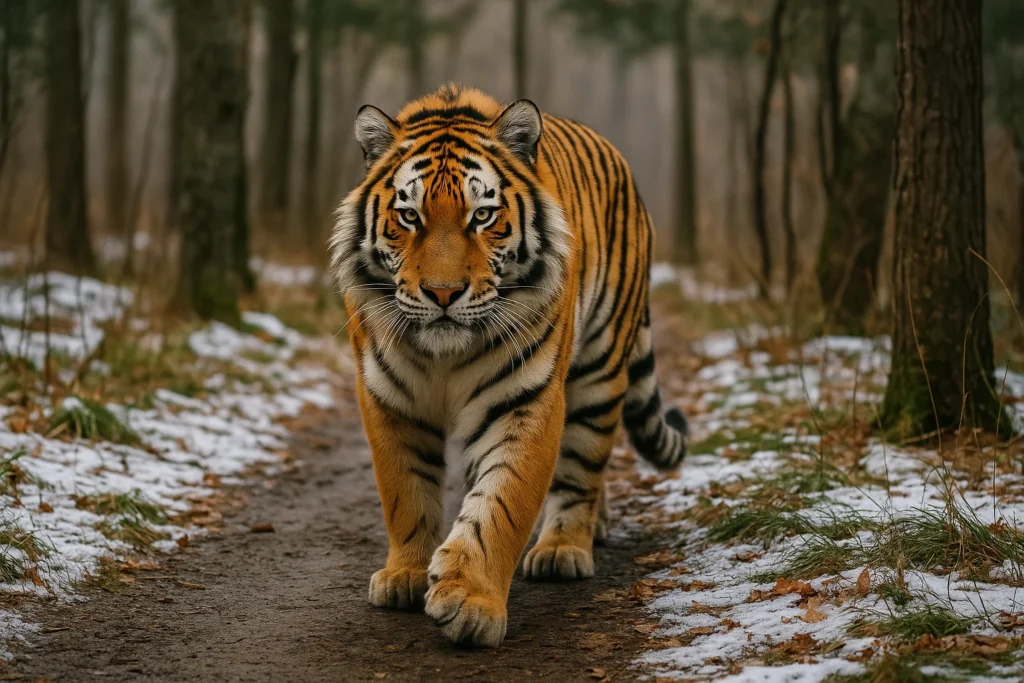For over half a century, the wild roar of a Siberian tiger cub was a sound largely unheard in the forests of Northern China. These magnificent creatures, also known as Amur tigers, had been pushed to the brink, their numbers dwindling due to habitat loss and poaching. But now, a quiet revolution is taking place in the vast, snowy landscapes of China’s northeast. Conservationists are celebrating a monumental success: the first confirmed wild births of Siberian tiger cubs in China in over 50 years. This isn’t just a handful of new stripes in the wilderness; it’s a powerful symbol of hope, a testament to years of dedicated effort, and a sign that a true rewilding success story is unfolding.
Imagine a hidden camera, nestled amongst the pines, capturing fleeting glimpses of a mother tiger, sleek and powerful, with her tiny, playful offspring trailing behind. This isn’t a scene from a documentary about a far-off, untouched wilderness. This is happening right now, thanks to ambitious conservation programs that are literally bringing the wild back to life in China.
A Ghost from the Past: The Decline of the Siberian Tiger in China
Once, Siberian tigers roamed widely across Northeast Asia, including large parts of northern China. They were the undisputed kings of their forest domain. However, the 20th century brought immense challenges. Rapid human population growth, deforestation for agriculture and timber, and intense hunting – both for their valuable fur and due to conflict with humans – devastated their numbers.
By the mid-20th century, the Siberian tiger population in China was virtually wiped out. Any tigers found were believed to be individuals crossing over from the healthier, though still vulnerable, population in Russia’s Far East. The forests were quiet, missing the apex predator that played such a crucial role in maintaining the balance of its ecosystem. The thought of wild-born cubs seemed like a distant echo from a bygone era.
The Roar Returns: A National Commitment to Rewilding
The tide began to turn with a monumental commitment from the Chinese government and dedicated conservation organizations. Recognizing the critical importance of these majestic animals, China embarked on an ambitious rewilding journey. This wasn’t just about protecting existing tigers; it was about creating the conditions for them to thrive and reproduce naturally in their historic range.
A cornerstone of this effort has been the establishment of the Northeast China Tiger and Leopard National Park. Officially established in 2021, this massive protected area spans over 1.4 million hectares across Jilin and Heilongjiang provinces, bordering Russia. It’s designed to be a safe haven, a connected landscape where tigers and leopards can move freely, hunt, and breed without human interference.
Beyond Fences: The Strategy for Success
Bringing back a top predator like the Siberian tiger requires a multifaceted approach that goes far beyond simply declaring a national park. Key strategies have included:
- Habitat Restoration: Large-scale reforestation efforts have been undertaken to restore degraded forestland, creating the dense cover and rich biodiversity that tigers need. This includes planting native tree species that support a healthy ecosystem.
- Prey Recovery: Tigers need food. Conservationists have focused on boosting populations of the tigers’ natural prey, such as wild boar, sika deer, and roe deer. This involves controlling poaching of prey animals and ensuring healthy habitat for them.
- Anti-Poaching Measures: Relentless patrols and advanced monitoring technologies, including thousands of infrared cameras and AI-driven analytics, have been deployed to deter and catch poachers. Removing snares and illegal hunting equipment is a continuous effort.
- Cross-Border Cooperation: Recognizing that tigers don’t respect national borders, China has engaged in vital collaboration with Russia, working together on conservation strategies and sharing data to protect the shared tiger population.
- Community Engagement: Local communities living near the park are crucial partners. Programs aim to educate residents about tiger conservation, mitigate human-wildlife conflict, and provide alternative livelihoods, ensuring that local people benefit from, rather than suffer from, the tigers’ return.
These combined efforts have created a sanctuary where tigers can truly be wild again.
The Patrolling Eyes: How We Know They’re Back
The confirmation of wild births isn’t just a lucky sighting. It’s the result of sophisticated monitoring systems. The Northeast China Tiger and Leopard National Park boasts an extensive network of nearly 28,000 infrared cameras. These cameras silently capture images and videos of wildlife, providing invaluable data on population numbers, distribution, and breeding activities.
When images emerge of a tigress with her tiny, striped cubs following closely behind, it’s a moment of triumph for the conservation teams. These visual proofs, combined with analysis of footprints (pugmarks) and other signs, confirm that the tigers are not just passing through, but are establishing territories and, most importantly, successfully reproducing within China’s borders. Recent reports indicate that the park has seen the birth of numerous new tiger cubs in the past year alone, with the total wild Siberian tiger population in China now estimated to be around 70 individuals, a significant increase from just a couple of decades ago.
A Symbol of Success: What the Tiger’s Return Means
The successful reintroduction and natural reproduction of Siberian tigers in China holds profound significance:
- Ecological Health: As apex predators, tigers are indicators of a healthy ecosystem. Their return signals that the entire food chain and habitat within the park are recovering.
- Biodiversity: The conservation efforts for tigers benefit countless other species within their habitat, from their prey animals to various bird and plant species.
- Global Conservation Efforts: China’s success provides a powerful model for other countries facing similar challenges with endangered species. It demonstrates that with sustained political will, scientific expertise, and community involvement, even species on the brink can be brought back from the edge.
- National Pride: The Siberian tiger is a majestic animal, deeply embedded in cultural lore. Its return evokes a sense of national pride and a renewed connection to China’s natural heritage.
This achievement underscores a global trend towards rewilding – actively restoring ecosystems and reintroducing native species to create resilient, self-sustaining natural environments.
Looking Ahead: Sustaining the Roar
While the celebration of new wild births is well-deserved, the work is far from over. Sustaining a healthy and growing Siberian tiger population in China requires ongoing commitment:
- Expanding Habitat: As tiger numbers grow, ensuring there’s enough suitable, connected habitat for them to expand into will be crucial.
- Continued Anti-Poaching: The threat of poaching remains, and vigilance must be maintained.
- Human-Wildlife Coexistence: As tiger populations increase, managing potential conflicts with local communities, particularly regarding livestock, will be an ongoing challenge that requires innovative solutions and compensation schemes.
- Genetic Diversity: Ensuring the long-term genetic health of the population is important to prevent inbreeding and maintain resilience.
The wild births of Siberian tiger cubs in Northern China are a powerful narrative of hope and perseverance. They represent a turning point in the fate of an iconic endangered species. The future of the “King of the Forest” in China looks brighter than it has in generations, with its wild roar once again echoing through the revitalized landscapes of the northeast.



